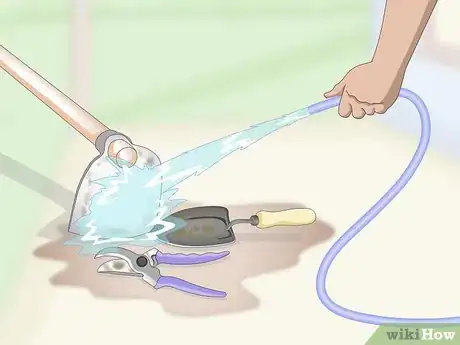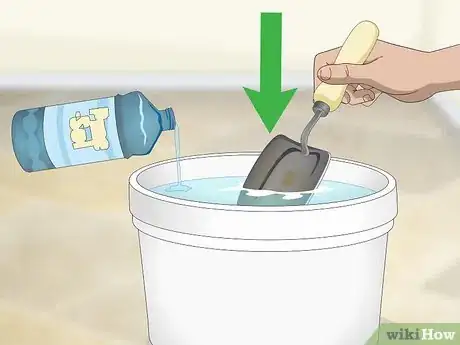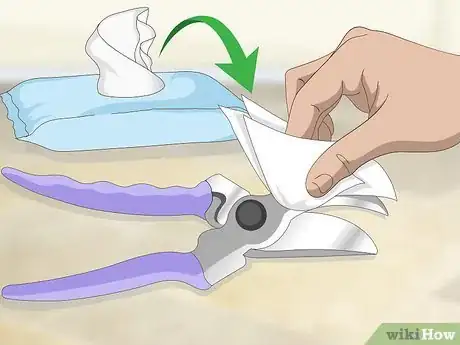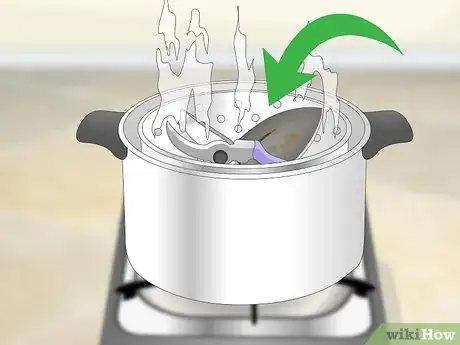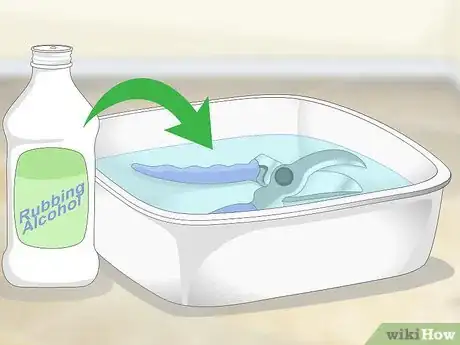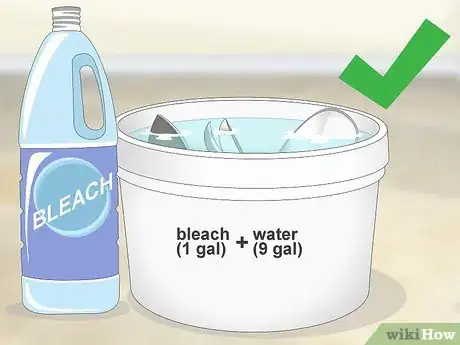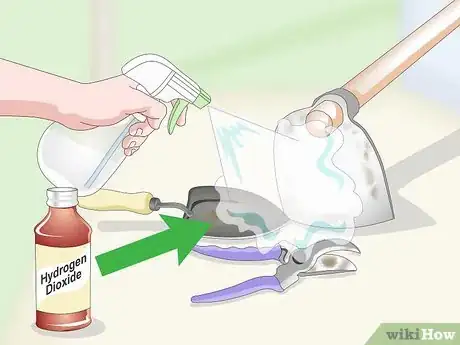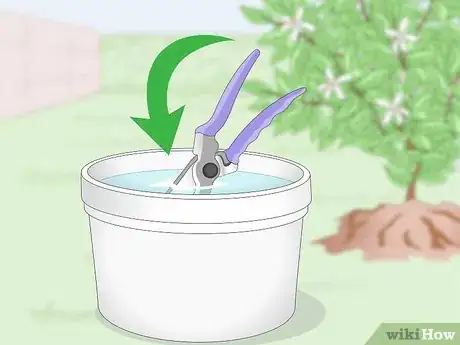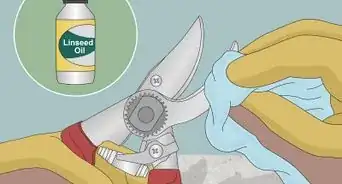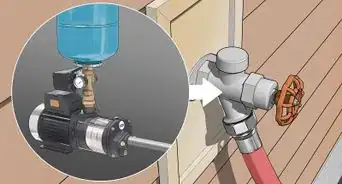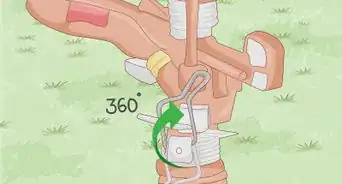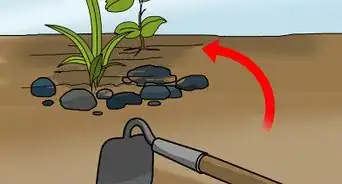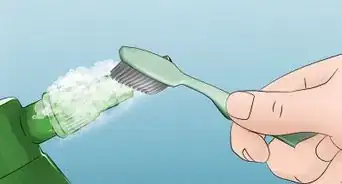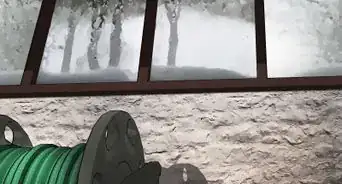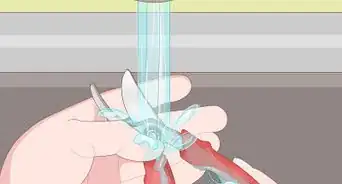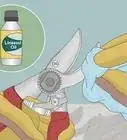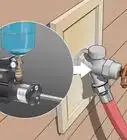This article was co-authored by Lauren Kurtz. Lauren Kurtz is a Naturalist and Horticultural Specialist. Lauren has worked for Aurora, Colorado managing the Water-Wise Garden at Aurora Municipal Center for the Water Conservation Department. She earned a BA in Environmental and Sustainability Studies from Western Michigan University in 2014.
wikiHow marks an article as reader-approved once it receives enough positive feedback. In this case, 100% of readers who voted found the article helpful, earning it our reader-approved status.
This article has been viewed 125,519 times.
Gardening tools used for trimming plants, pruning bushes, removing weeds, and digging soil should be disinfected regularly to prevent transmission of plant pests and diseases. Before you begin the disinfection process, clean the tools to remove dirt, debris, and plant residue. This will ensure that the disinfectant contacts the entire surface of the tool. Then, spray the disinfectant of your choice on your tool, or soak the tool in the disinfectant.
Steps
Cleaning the Tools
-
1Remove dirt and debris from tools with water. Before disinfecting tools, remove dirt and grime using a forceful stream of water. Wash them beneath a strong spigot, or use a hose with a jet-stream setting. Clean tools are easier to use and disinfect.
-
2Scrub tools that aren’t easy to clean. Some soils are difficult to wash off. If you’re having trouble removing dirt and debris from your gardening tools with just water, use a stiff wire-bristle brush or a scraping tool (a caulking knife, for instance) to remove the caked-on material.Advertisement
-
3Wipe away sap and resin using a disinfectant. If your tools have any sticky residue on them, such as sap or resin, wipe the affected tools with a cloth or paper towel dampened with a disinfectant.[1] If the sap or resin resists removal, wipe the affected area vigorously with paint thinner.
Disinfecting with Less Corrosive Methods
-
1Disinfect your tools with a household cleaner. Commercial household disinfectants (such as Lysol or Simple Green D) can be used to disinfect your gardening tools. The advantage of these types of disinfectants is that they are relatively gentle on you and your tools compared to bleach or industrial cleansers. Fill a bucket with a household cleaner of your choice. Soak the tool in it for a couple minutes, then remove it.[2]
- To reduce the corrosive aspect of household cleaners further, combine them in a solution of one part cleaner and five parts water.
-
2Use disinfectant wipes. Some gardening stores might offer disposable disinfectant wipes for gardening tools. You can also use general purpose wipes, such as Lysol or Clorox disinfecting wipes. To use the disinfectant wipe, remove it from its container and wipe the tool thoroughly. Throw away the wipe after use.[3]
- You might need to use more than one wipe per tool.
-
3Use steam or dry heat to clean your gardening tools. Heat your gardening tools to 180°-200° F (82°-93° C) under a cover for about 30 minutes. For instance, you might place some of your smaller gardening tools on a steam basket, cover it, then steam them on the stove for half an hour.[4]
-
4Use 70% isopropyl alcohol to disinfect your tools. Dip the tools you want to clean in the alcohol, then remove them and allow them to dry. Alternately, wet a rag with alcohol and wipe the gardening tools down.[5]
- You could use wood, grain, or rubbing alcohol.
- There’s no need to rinse your tools after using alcohol.
- Don’t use alcohol around fire or a strong heat source.
Disinfecting with More Corrosive Methods
-
1Use liquid bleach. Mix one part liquid bleach with nine parts water.[6] Dip your gardening tools in the mixture, then remove them and let the material drain off. Alternately, spray or brush the mixture onto the gardening tools and allow it to drain off. Rinse the remaining mixture off the object after most of it has drained away.[7]
- Liquid bleach is sold under trademarked names like Clorox, Everchlor, Hypo, Bridos, Bleacol, and Hispec.
- Bleach is one of the most corrosive of all gardening tool disinfectants.[8]
- If inhaled, bleach may cause damage to your nose, throat and lungs. It can also damage or irritate your skin. Always wear protective masks and rubber gloves when cleaning tools with bleach solutions.
-
2Clean your tools with an industrial disinfectant. If you have diseased plants, you may wish to get an industrial-grade gardening disinfectant to help prevent the problem from spreading. The most common varieties are “quats” (or “q-salts”) and hydrogen peroxide-based cleansers. Purchase the disinfectant of your choice from a horticulture or garden supply store, and follow all package directions and warnings carefully.[9]
- These industrial products are formulated to kill algae, fungus, bacteria, and spores immediately on contact.
- A few common commercial Q-salt products are Green-Shield, Physan 20, and KleenGrow.
- Hydrogen peroxide (or hydrogen dioxide) is marketed under trademarked names like ZeroTol and TerraClean.
-
3Disinfect your tools regularly when working on infected plants. If you’re using your gardening tools on diseased plants, shrubs, or trees, treat your tools with a disinfectant after every use. This will prevent the disease from spreading throughout a plant or between plants.
Expert Q&A
Did you know you can get expert answers for this article?
Unlock expert answers by supporting wikiHow
-
QuestionWhat should I use to clean pruning shears?
 Maggie MoranMaggie Moran is a Professional Gardener in Pennsylvania.
Maggie MoranMaggie Moran is a Professional Gardener in Pennsylvania.
Home & Garden Specialist
-
QuestionCan methylated spirits be used as a disinfectant?
 Maggie MoranMaggie Moran is a Professional Gardener in Pennsylvania.
Maggie MoranMaggie Moran is a Professional Gardener in Pennsylvania.
Home & Garden Specialist
-
QuestionHow do you clean garden tools?
 Maggie MoranMaggie Moran is a Professional Gardener in Pennsylvania.
Maggie MoranMaggie Moran is a Professional Gardener in Pennsylvania.
Home & Garden Specialist
References
- ↑ http://extension.psu.edu/pests/plant-diseases/all-fact-sheets/disinfecting-tools-and-equipment
- ↑ https://cals.arizona.edu/yavapai/anr/hort/byg/archive/sanitizingpruningtools.html
- ↑ https://davesgarden.com/guides/articles/view/903
- ↑ http://extension.psu.edu/pests/plant-diseases/all-fact-sheets/disinfecting-tools-and-equipment
- ↑ http://extension.psu.edu/pests/plant-diseases/all-fact-sheets/disinfecting-tools-and-equipment
- ↑ http://gardeningsolutions.ifas.ufl.edu/care/tools-and-equipment/disinfecting-tools.html
- ↑ http://extension.psu.edu/pests/plant-diseases/all-fact-sheets/disinfecting-tools-and-equipment
- ↑ https://cals.arizona.edu/yavapai/anr/hort/byg/archive/sanitizingpruningtools.html
- ↑ http://extension.psu.edu/pests/plant-diseases/all-fact-sheets/disinfecting-tools-and-equipment
About This Article
To disinfect your gardening tools, start by removing any dirt and debris with water. If the grime is caked on, use a stiff wire-bristle brush to remove the dirt and a paper towel dampened with disinfectant or paint thinner to remove any sticky residue. Once you’re ready to disinfect your tools, dip them in 70% isopropyl alcohol or a mixture of 9 parts bleach to 1 part water. Alternatively, try rubbing your tools down with disinfectant wipes, or soaking them in a commercial household disinfectant for a few minutes. For more tips from our Horticultural co-author, including how to disinfect tools when working with diseased plants, keep reading!
